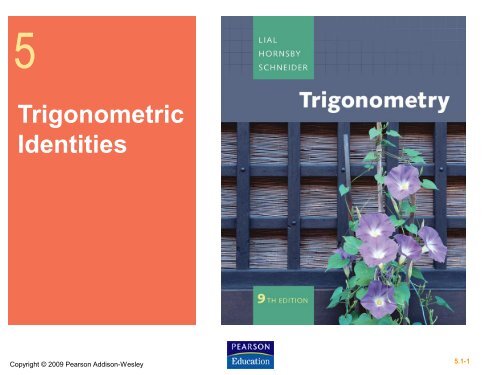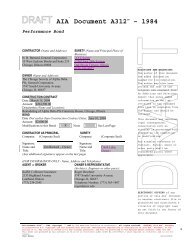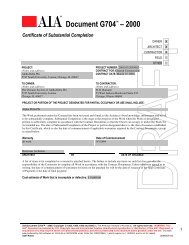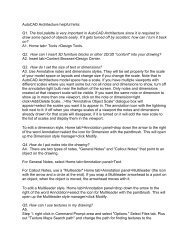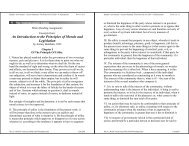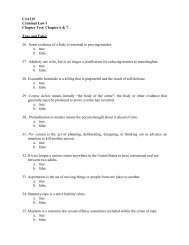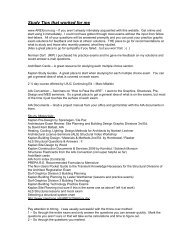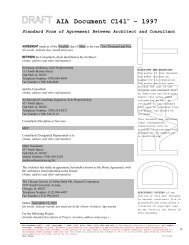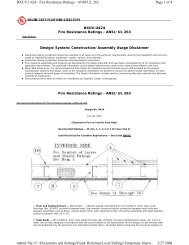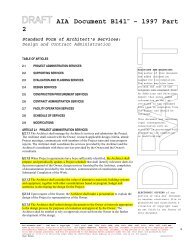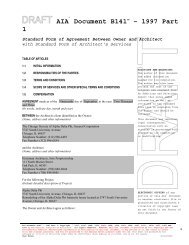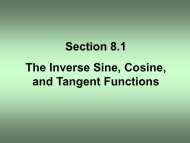Trigonometric Identities
Trigonometric Identities
Trigonometric Identities
You also want an ePaper? Increase the reach of your titles
YUMPU automatically turns print PDFs into web optimized ePapers that Google loves.
5<br />
<strong>Trigonometric</strong><br />
<strong>Identities</strong><br />
Copyright © 2009 Pearson Addison-Wesley<br />
5.1-1
5 <strong>Trigonometric</strong> <strong>Identities</strong><br />
5.1 Fundamental <strong>Identities</strong><br />
5.2 Verifying <strong>Trigonometric</strong> <strong>Identities</strong><br />
5.3 Sum and Difference <strong>Identities</strong> for Cosine<br />
5.4 Sum and Difference <strong>Identities</strong> for Sine<br />
and Tangent<br />
5.5 Double-Angle <strong>Identities</strong><br />
5.6 Half-Angle <strong>Identities</strong><br />
Copyright © 2009 Pearson Addison-Wesley<br />
5.1-2
5.1<br />
Fundamental <strong>Identities</strong><br />
Fundamental <strong>Identities</strong> Using the Fundamental <strong>Identities</strong><br />
Copyright © 2009 Pearson Addison-Wesley 1.1-3<br />
5.1-3
Fundamental <strong>Identities</strong><br />
Reciprocal <strong>Identities</strong><br />
Quotient <strong>Identities</strong><br />
Copyright © 2009 Pearson Addison-Wesley 1.1-4<br />
5.1-4
Fundamental <strong>Identities</strong><br />
Pythagorean <strong>Identities</strong><br />
Negative-Angle <strong>Identities</strong><br />
Copyright © 2009 Pearson Addison-Wesley 1.1-5<br />
5.1-5
Note<br />
In trigonometric identities, θ can be<br />
an angle in degrees, an angle in<br />
radians, a real number, or a variable.<br />
Copyright © 2009 Pearson Addison-Wesley 1.1-6<br />
5.1-6
Example 1<br />
If and θ is in quadrant II, find each function<br />
value.<br />
(a) sec θ<br />
Copyright © 2009 Pearson Addison-Wesley 1.1-7<br />
FINDING TRIGONOMETRIC FUNCTION<br />
VALUES GIVEN ONE VALUE AND THE<br />
QUADRANT<br />
In quadrant II, sec θ is negative, so<br />
Pythagorean<br />
identity<br />
5.1-7
Example 1<br />
(b) sin θ<br />
from part (a)<br />
Copyright © 2009 Pearson Addison-Wesley 1.1-8<br />
FINDING TRIGONOMETRIC FUNCTION<br />
VALUES GIVEN ONE VALUE AND THE<br />
QUADRANT (continued)<br />
Quotient identity<br />
Reciprocal identity<br />
5.1-8
Example 1<br />
(b) cot(– θ)<br />
Copyright © 2009 Pearson Addison-Wesley 1.1-9<br />
FINDING TRIGONOMETRIC FUNCTION<br />
VALUES GIVEN ONE VALUE AND THE<br />
QUADRANT (continued)<br />
Reciprocal identity<br />
Negative-angle<br />
identity<br />
5.1-9
Caution<br />
To avoid a common error, when<br />
taking the square root, be sure to<br />
choose the sign based on the<br />
quadrant of θ and the function being<br />
evaluated.<br />
Copyright © 2009 Pearson Addison-Wesley 1.1-10<br />
5.1-10
Example 2<br />
Express cos x in terms of tan x.<br />
Copyright © 2009 Pearson Addison-Wesley 1.1-11<br />
EXPRESSING ONE FUNCITON IN<br />
TERMS OF ANOTHER<br />
Since sec x is related to both cos x and tan x by<br />
identities, start with<br />
Take reciprocals.<br />
Reciprocal identity<br />
Take the square<br />
root of each side.<br />
The sign depends on<br />
the quadrant of x.<br />
5.1-11
Example 3<br />
Write tan θ + cot θ in terms of sin θ and cos θ, and<br />
then simplify the expression.<br />
Copyright © 2009 Pearson Addison-Wesley 1.1-12<br />
REWRITING AN EXPRESSION IN<br />
TERMS OF SINE AND COSINE<br />
Quotient identities<br />
Write each fraction<br />
with the LCD.<br />
Pythagorean identity<br />
5.1-12
Caution<br />
When working with trigonometric<br />
expressions and identities, be sure<br />
to write the argument of the function.<br />
For example, we would not write<br />
An argument such as θ<br />
is necessary.<br />
Copyright © 2009 Pearson Addison-Wesley 1.1-13<br />
5.1-13
5<br />
<strong>Trigonometric</strong><br />
<strong>Identities</strong><br />
Copyright © 2009 Pearson Addison-Wesley<br />
5.2-1
5 <strong>Trigonometric</strong> <strong>Identities</strong><br />
5.1 Fundamental <strong>Identities</strong><br />
5.2 Verifying <strong>Trigonometric</strong> <strong>Identities</strong><br />
5.3 Sum and Difference <strong>Identities</strong> for Cosine<br />
5.4 Sum and Difference <strong>Identities</strong> for Sine<br />
and Tangent<br />
5.5 Double-Angle <strong>Identities</strong><br />
5.6 Half-Angle <strong>Identities</strong><br />
Copyright © 2009 Pearson Addison-Wesley<br />
5.2-2
5.2<br />
Verifying <strong>Trigonometric</strong><br />
<strong>Identities</strong><br />
Verifying <strong>Identities</strong> by Working With One Side ▪ Verifying<br />
<strong>Identities</strong> by Working With Both Sides<br />
Copyright © 2009 Pearson Addison-Wesley 1.1-3<br />
5.2-3
Hints for Verifying <strong>Identities</strong><br />
Learn the fundamental identities.<br />
Whenever you see either side of a<br />
fundamental identity, the other side should<br />
come to mind. Also, be aware of equivalent<br />
forms of the fundamental identities.<br />
Try to rewrite the more complicated<br />
side of the equation so that it is<br />
identical to the simpler side.<br />
Copyright © 2009 Pearson Addison-Wesley 1.1-4<br />
5.2-4
Hints for Verifying <strong>Identities</strong><br />
It is sometimes helpful to express all<br />
trigonometric functions in the<br />
equation in terms of sine and cosine<br />
and then simplify the result.<br />
Usually, any factoring or indicated<br />
algebraic operations should be<br />
performed.<br />
For example, the expression<br />
can be factored as<br />
Copyright © 2009 Pearson Addison-Wesley 1.1-5<br />
5.2-5
Hints for Verifying <strong>Identities</strong><br />
The sum or difference of two trigonometric<br />
expressions such as can be<br />
added or subtracted in the same way as<br />
any other rational expression.<br />
Copyright © 2009 Pearson Addison-Wesley 1.1-6<br />
5.2-6
Hints for Verifying <strong>Identities</strong><br />
As you select substitutions, keep in<br />
mind the side you are not changing,<br />
because it represents your goal.<br />
For example, to verify the identity<br />
find an identity that relates tan x to cos x.<br />
Since and<br />
the secant function is the best link between<br />
the two sides.<br />
Copyright © 2009 Pearson Addison-Wesley 1.1-7<br />
5.2-7
Hints for Verifying <strong>Identities</strong><br />
If an expression contains 1 + sin x,<br />
multiplying both the numerator and<br />
denominator by 1 – sin x would give<br />
1 – sin2 x, which could be replaced<br />
with cos2x.<br />
Similar results for 1 – sin x, 1 + cos x, and<br />
1 – cos x may be useful.<br />
Copyright © 2009 Pearson Addison-Wesley 1.1-8<br />
5.2-8
Caution<br />
Verifying identities is not the same a<br />
solving equations.<br />
Techniques used in solving equations,<br />
such as adding the same terms to both<br />
sides, should not be used when<br />
working with identities since you are<br />
starting with a statement that may not<br />
be true.<br />
Copyright © 2009 Pearson Addison-Wesley 1.1-9<br />
5.2-9
Verifying <strong>Identities</strong> by Working<br />
with One Side<br />
To avoid the temptation to use algebraic properties<br />
of equations to verify identities, one strategy is to<br />
work with only one side and rewrite it to match<br />
the other side.<br />
Copyright © 2009 Pearson Addison-Wesley<br />
5.2-10
Example 1<br />
Copyright © 2009 Pearson Addison-Wesley 1.1-11<br />
VERIFYING AN IDENTITY (WORKING<br />
WITH ONE SIDE)<br />
Verify that is an identity.<br />
Work with the right side since it is more complicated.<br />
Right side of given<br />
equation<br />
Left side of given<br />
equation<br />
Distributive<br />
property<br />
5.2-11
Example 2<br />
Copyright © 2009 Pearson Addison-Wesley 1.1-12<br />
VERIFYING AN IDENTITY (WORKING<br />
WITH ONE SIDE)<br />
Verify that is an identity.<br />
Left side<br />
Right side<br />
Distributive<br />
property<br />
5.2-12
Example 3<br />
Copyright © 2009 Pearson Addison-Wesley 1.1-13<br />
VERIFYING AN IDENTITY (WORKING<br />
WITH ONE SIDE)<br />
Verify that is an identity.<br />
5.2-13
Example 4<br />
Copyright © 2009 Pearson Addison-Wesley 1.1-14<br />
VERIFYING AN IDENTITY (WORKING<br />
WITH ONE SIDE)<br />
Verify that is an identity.<br />
Multiply by 1<br />
in the form<br />
5.2-14
Verifying <strong>Identities</strong> by Working<br />
with Both Sides<br />
If both sides of an identity appear to be equally<br />
complex, the identity can be verified by working<br />
independently on each side until they are changed<br />
into a common third result.<br />
Each step, on each side, must be reversible.<br />
Copyright © 2009 Pearson Addison-Wesley<br />
5.2-15
Example 5<br />
Copyright © 2009 Pearson Addison-Wesley 1.1-16<br />
VERIFYING AN IDENTITY (WORKING<br />
WITH BOTH SIDES)<br />
Verify that is an<br />
identity.<br />
Working with the left side:<br />
Multiply by 1<br />
in the form<br />
Distributive<br />
property<br />
5.2-16
Example 5<br />
Working with the right side:<br />
Copyright © 2009 Pearson Addison-Wesley 1.1-17<br />
VERIFYING AN IDENTITY (WORKING<br />
WITH BOTH SIDES) (continued)<br />
Factor the numerator.<br />
Factor the<br />
denominator.<br />
5.2-17
Example 5<br />
Right side of given<br />
equation<br />
Copyright © 2009 Pearson Addison-Wesley 1.1-18<br />
VERIFYING AN IDENTITY (WORKING<br />
WITH BOTH SIDES) (continued)<br />
Common third<br />
expression<br />
So, the identity is verified.<br />
Left side of given<br />
equation<br />
5.2-18
Example 6<br />
Copyright © 2009 Pearson Addison-Wesley 1.1-19<br />
APPLYING A PYTHAGOREAN IDENTITY<br />
TO RADIOS<br />
Tuners in radios select a radio station by adjusting<br />
the frequency. A tuner may contain an inductor L and<br />
a capacitor. The energy stored in the inductor at time<br />
t is given by<br />
and the energy in the capacitor is given by<br />
where f is the frequency of the radio station and k is a<br />
constant.<br />
5.2-19
Example 6<br />
Copyright © 2009 Pearson Addison-Wesley 1.1-20<br />
APPLYING A PYTHAGOREAN IDENTITY<br />
TO RADIOS (continued)<br />
The total energy in the circuit is given by<br />
Show that E is a constant function.*<br />
*(Source: Weidner, R. and R. Sells, Elementary Classical Physics, Vol. 2,<br />
Allyn & Bacon, 1973.)<br />
5.2-20
Example 6<br />
Copyright © 2009 Pearson Addison-Wesley 1.1-21<br />
APPLYING A PYTHAGOREAN IDENTITY<br />
TO RADIOS (continued)<br />
Factor.<br />
5.2-21
5<br />
<strong>Trigonometric</strong><br />
<strong>Identities</strong><br />
Copyright © 2009 Pearson Addison-Wesley<br />
5.2-1
5 <strong>Trigonometric</strong> <strong>Identities</strong><br />
5.1 Fundamental <strong>Identities</strong><br />
5.2 Verifying <strong>Trigonometric</strong> <strong>Identities</strong><br />
5.3 Sum and Difference <strong>Identities</strong> for Cosine<br />
5.4 Sum and Difference <strong>Identities</strong> for Sine<br />
and Tangent<br />
5.5 Double-Angle <strong>Identities</strong><br />
5.6 Half-Angle <strong>Identities</strong><br />
Copyright © 2009 Pearson Addison-Wesley<br />
5.2-2
5.3<br />
Sum and Difference<br />
Identitites for Cosine<br />
Difference Identity for Cosine ▪ Sum Identity for Cosine ▪<br />
Cofunction <strong>Identities</strong> ▪ Applying the Sum and Difference <strong>Identities</strong><br />
Copyright © 2009 Pearson Addison-Wesley 1.1-3<br />
5.2-3
Difference Identity for Cosine<br />
Point Q is on the unit<br />
circle, so the coordinates<br />
of Q are (cos B, sin B).<br />
The coordinates of S are<br />
(cos A, sin A).<br />
The coordinates of R are (cos(A – B), sin (A – B)).<br />
Copyright © 2009 Pearson Addison-Wesley<br />
5.2-4
Difference Identity for Cosine<br />
Since the central angles<br />
SOQ and POR are<br />
equal, PR = SQ.<br />
Using the distance formula,<br />
we have<br />
Copyright © 2009 Pearson Addison-Wesley<br />
5.2-5
Difference Identity for Cosine<br />
Square both sides and clear parentheses:<br />
Rearrange the terms:<br />
Copyright © 2009 Pearson Addison-Wesley<br />
5.2-6
Difference Identity for Cosine<br />
Subtract 2, then divide by –2:<br />
Copyright © 2009 Pearson Addison-Wesley<br />
5.2-7
Copyright © 2009 Pearson Addison-Wesley<br />
Sum Identity for Cosine<br />
To find a similar expression for cos(A + B) rewrite<br />
A + B as A – (–B) and use the identity for<br />
cos(A – B).<br />
Cosine difference identity<br />
Negative angle identities<br />
5.2-8
Cosine of a Sum or Difference<br />
Copyright © 2009 Pearson Addison-Wesley 1.1-9<br />
5.2-9
Example 1(a)<br />
Find the exact value of cos 15 .<br />
Copyright © 2009 Pearson Addison-Wesley 1.1-10<br />
FINDING EXACT COSINE FUNCTION<br />
VALUES<br />
5.2-10
Example 1(b)<br />
Find the exact value of<br />
Copyright © 2009 Pearson Addison-Wesley 1.1-11<br />
FINDING EXACT COSINE FUNCTION<br />
VALUES<br />
5.2-11
Example 1(c)<br />
Copyright © 2009 Pearson Addison-Wesley 1.1-12<br />
FINDING EXACT COSINE FUNCTION<br />
VALUES<br />
Find the exact value of cos 87 cos 93 – sin 87 sin 93 .<br />
5.2-12
Cofunction <strong>Identities</strong><br />
Similar identities can be obtained for a<br />
real number domain by replacing 90<br />
with<br />
Copyright © 2009 Pearson Addison-Wesley 1.1-13<br />
5.2-13
Example 2<br />
Copyright © 2009 Pearson Addison-Wesley 1.1-14<br />
USING COFUNCTION IDENTITIES TO<br />
FIND θ<br />
Find an angle that satisfies each of the following:<br />
(a) cot θ = tan 25<br />
(b) sin θ = cos (–30 )<br />
5.2-14
Example 2<br />
Copyright © 2009 Pearson Addison-Wesley 1.1-15<br />
USING COFUNCTION IDENTITIES TO<br />
FIND θ<br />
Find an angle that satisfies each of the following:<br />
(c)<br />
5.2-15
Note<br />
Because trigonometric (circular)<br />
functions are periodic, the solutions<br />
in Example 2 are not unique. Only<br />
one of infinitely many possiblities<br />
are given.<br />
Copyright © 2009 Pearson Addison-Wesley 1.1-16<br />
5.2-16
Applying the Sum and Difference<br />
Copyright © 2009 Pearson Addison-Wesley<br />
<strong>Identities</strong><br />
If one of the angles A or B in the identities for<br />
cos(A + B) and cos(A – B) is a quadrantal angle,<br />
then the identity allows us to write the expression<br />
in terms of a single function of A or B.<br />
5.2-17
Example 3<br />
Copyright © 2009 Pearson Addison-Wesley 1.1-18<br />
REDUCING cos (A – B) TO A FUNCTION<br />
OF A SINGLE VARIABLE<br />
Write cos(90 + θ) as a trigonometric function of θ<br />
alone.<br />
5.2-18
Example 4<br />
Copyright © 2009 Pearson Addison-Wesley 1.1-19<br />
FINDING cos (s + t) GIVEN<br />
INFORMATION ABOUT s AND t<br />
Suppose that and both s and t<br />
are in quadrant II. Find cos(s + t).<br />
Sketch an angle s in quadrant II<br />
such that Since<br />
let y = 3 and r = 5.<br />
The Pythagorean theorem gives<br />
Since s is in quadrant II, x = –4 and<br />
5.2-19
Example 4<br />
Sketch an angle t in quadrant II<br />
such that Since<br />
r = 5.<br />
Copyright © 2009 Pearson Addison-Wesley 1.1-20<br />
FINDING cos (s + t) GIVEN<br />
INFORMATION ABOUT s AND t (cont.)<br />
let x = –12 and<br />
The Pythagorean theorem gives<br />
Since t is in quadrant II, y = 5 and<br />
5.2-20
Example 4<br />
Copyright © 2009 Pearson Addison-Wesley 1.1-21<br />
FINDING cos (s + t) GIVEN<br />
INFORMATION ABOUT s AND t (cont.)<br />
5.2-21
Note<br />
The values of cos s and sin t could<br />
also be found by using the<br />
Pythagorean identities.<br />
Copyright © 2009 Pearson Addison-Wesley 1.1-22<br />
5.2-22
Example 5<br />
Copyright © 2009 Pearson Addison-Wesley 1.1-23<br />
APPLYING THE COSINE DIFFERENCE<br />
IDENTITY TO VOLTAGE<br />
Common household current is called alternating<br />
current because the current alternates direction<br />
within the wires. The voltage V in a typical 115-volt<br />
outlet can be expressed by the function<br />
where ω is the angular speed (in radians per second)<br />
of the rotating generator at the electrical plant, and t<br />
is time measured in seconds.*<br />
*(Source: Bell, D., Fundamentals of Electric Circuits, Fourth Edition,<br />
Prentice-Hall, 1988.)<br />
5.2-23
Example 5<br />
Copyright © 2009 Pearson Addison-Wesley 1.1-24<br />
APPLYING THE COSINE DIFFERENCE<br />
IDENTITY TO VOLTAGE (continued)<br />
(a) It is essential for electric generators to rotate at<br />
precisely 60 cycles per second so household<br />
appliances and computers will function properly.<br />
Determine ω for these electric generators.<br />
Each cycle is 2π radians at 60 cycles per second, so<br />
the angular speed is ω = 60(2π) = 120π radians per<br />
second.<br />
5.2-24
Example 5<br />
Copyright © 2009 Pearson Addison-Wesley 1.1-25<br />
APPLYING THE COSINE DIFFERENCE<br />
IDENTITY TO VOLTAGE (continued)<br />
(b) Graph V in the window [0, .05] by [–200, 200].<br />
5.2-25
Example 5<br />
Copyright © 2009 Pearson Addison-Wesley 1.1-26<br />
APPLYING THE COSINE DIFFERENCE<br />
IDENTITY TO VOLTAGE (continued)<br />
(c) Determine a value of so that the graph of<br />
is the same as the graph of<br />
Using the negative-angle identity for cosine and a<br />
cofunction identity gives<br />
Therefore, if<br />
5.2-26
5<br />
<strong>Trigonometric</strong><br />
<strong>Identities</strong><br />
Copyright © 2009 Pearson Addison-Wesley<br />
5.4-1
5 <strong>Trigonometric</strong> <strong>Identities</strong><br />
5.1 Fundamental <strong>Identities</strong><br />
5.2 Verifying <strong>Trigonometric</strong> <strong>Identities</strong><br />
5.3 Sum and Difference <strong>Identities</strong> for Cosine<br />
5.4 Sum and Difference <strong>Identities</strong> for Sine<br />
and Tangent<br />
5.5 Double-Angle <strong>Identities</strong><br />
5.6 Half-Angle <strong>Identities</strong><br />
Copyright © 2009 Pearson Addison-Wesley<br />
5.4-2
5.4<br />
Sum and Difference <strong>Identities</strong><br />
for Sine and Tangent<br />
Sum and Difference <strong>Identities</strong> for Sine ▪ Sum and Difference<br />
<strong>Identities</strong> for Tangent ▪ Applying the Sum and Difference <strong>Identities</strong><br />
Copyright © 2009 Pearson Addison-Wesley 1.1-3<br />
5.4-3
Sum and Difference <strong>Identities</strong><br />
for Sine<br />
We can use the cosine sum and difference identities<br />
to derive similar identities for sine and tangent.<br />
Copyright © 2009 Pearson Addison-Wesley<br />
Cofunction identity<br />
Cosine difference identity<br />
Cofunction identities<br />
5.4-4
Sum and Difference <strong>Identities</strong><br />
for Sine<br />
Copyright © 2009 Pearson Addison-Wesley<br />
Sine sum identity<br />
Negative-angle identities<br />
5.4-5
Sine of a Sum or Difference<br />
Copyright © 2009 Pearson Addison-Wesley 1.1-6<br />
5.4-6
Sum and Difference <strong>Identities</strong><br />
for Tangent<br />
We can use the cosine sum and difference identities<br />
to derive similar identities for sine and tangent.<br />
Copyright © 2009 Pearson Addison-Wesley<br />
Fundamental identity<br />
Sum identities<br />
Multiply numerator and<br />
denominator by 1.<br />
5.4-7
Sum and Difference <strong>Identities</strong><br />
for Tangent<br />
Copyright © 2009 Pearson Addison-Wesley<br />
Multiply.<br />
Simplify.<br />
Fundamental<br />
identity<br />
5.4-8
Sum and Difference <strong>Identities</strong><br />
for Tangent<br />
Replace B with –B and use the fact that tan(–B) to<br />
obtain the identity for the tangent of the difference of<br />
two angles.<br />
Copyright © 2009 Pearson Addison-Wesley<br />
5.4-9
Tangent of a Sum or Difference<br />
Copyright © 2009 Pearson Addison-Wesley 1.1-10<br />
5.4-10
Example 1(a)<br />
Find the exact value of sin 75 .<br />
Copyright © 2009 Pearson Addison-Wesley 1.1-11<br />
FINDING EXACT SINE AND TANGENT<br />
FUNCTION VALUES<br />
5.4-11
Example 1(b)<br />
Find the exact value of<br />
Copyright © 2009 Pearson Addison-Wesley 1.1-12<br />
FINDING EXACT SINE AND TANGENT<br />
FUNCTION VALUES<br />
5.4-12
Example 1(c)<br />
Find the exact value of<br />
Copyright © 2009 Pearson Addison-Wesley 1.1-13<br />
FINDING EXACT SINE AND TANGENT<br />
FUNCTION VALUES<br />
5.4-13
Example 2<br />
Copyright © 2009 Pearson Addison-Wesley 1.1-14<br />
WRITING FUNCTIONS AS EXPRESSIONS<br />
INVOLVING FUNCTIONS OF θ<br />
Write each function as an expression involving<br />
functions of θ.<br />
(a)<br />
(b)<br />
(c)<br />
5.4-14
Example 3<br />
Copyright © 2009 Pearson Addison-Wesley 1.1-15<br />
FINDING FUNCTION VALUES AND THE<br />
QUADRANT OF A + B<br />
Suppose that A and B are angles in standard position<br />
with<br />
Find each of the following.<br />
5.4-15
Example 3<br />
Copyright © 2009 Pearson Addison-Wesley 1.1-16<br />
FINDING FUNCTION VALUES AND THE<br />
QUADRANT OF A + B (continued)<br />
The identity for sin(A + B) requires sin A, cos A, sin B,<br />
and cos B. The identity for tan(A + B) requires tan A<br />
and tan B. We must find cos A, tan A, sin B and tan B.<br />
Because A is in quadrant II, cos A is negative and<br />
tan A is negative.<br />
5.4-16
Example 3<br />
Copyright © 2009 Pearson Addison-Wesley 1.1-17<br />
FINDING FUNCTION VALUES AND THE<br />
QUADRANT OF A + B (continued)<br />
Because B is in quadrant III, sin B is negative and<br />
tan B is positive.<br />
5.4-17
(a)<br />
(b)<br />
Example 3<br />
Copyright © 2009 Pearson Addison-Wesley 1.1-18<br />
FINDING FUNCTION VALUES AND THE<br />
QUADRANT OF A + B (continued)<br />
5.4-18
Example 3<br />
Copyright © 2009 Pearson Addison-Wesley 1.1-19<br />
FINDING FUNCTION VALUES AND THE<br />
QUADRANT OF A + B (continued)<br />
From parts (a) and (b), sin (A + B) > 0 and<br />
tan (A − B) > 0.<br />
The only quadrant in which the values of both the<br />
sine and the tangent are positive is quadrant I, so<br />
(A + B) is in quadrant IV.<br />
5.4-19
Example 4<br />
Copyright © 2009 Pearson Addison-Wesley 1.1-20<br />
VERIFYING AN IDENTITY USING SUM<br />
AND DIFFERENCE IDENTITIES<br />
Verify that the equation is an identity.<br />
5.4-20
5<br />
<strong>Trigonometric</strong><br />
<strong>Identities</strong><br />
Copyright © 2009 Pearson Addison-Wesley<br />
5.5-1
5 <strong>Trigonometric</strong> <strong>Identities</strong><br />
5.1 Fundamental <strong>Identities</strong><br />
5.2 Verifying <strong>Trigonometric</strong> <strong>Identities</strong><br />
5.3 Sum and Difference <strong>Identities</strong> for Cosine<br />
5.4 Sum and Difference <strong>Identities</strong> for Sine<br />
and Tangent<br />
5.5 Double-Angle <strong>Identities</strong><br />
5.6 Half-Angle <strong>Identities</strong><br />
Copyright © 2009 Pearson Addison-Wesley<br />
5.5-2
5.5<br />
Double-Angle <strong>Identities</strong><br />
Double-Angle <strong>Identities</strong> ▪ An Application ▪ Product-to-Sum and<br />
Sum-to-Product <strong>Identities</strong><br />
Copyright © 2009 Pearson Addison-Wesley 1.1-3<br />
5.5-3
Copyright © 2009 Pearson Addison-Wesley<br />
Double-Angle <strong>Identities</strong><br />
We can use the cosine sum identity to derive<br />
double-angle identities for cosine.<br />
Cosine sum identity<br />
5.5-4
Copyright © 2009 Pearson Addison-Wesley<br />
Double-Angle <strong>Identities</strong><br />
There are two alternate forms of this identity.<br />
5.5-5
Copyright © 2009 Pearson Addison-Wesley<br />
Double-Angle <strong>Identities</strong><br />
We can use the sine sum identity to derive a<br />
double-angle identity for sine.<br />
Sine sum identity<br />
5.5-6
Copyright © 2009 Pearson Addison-Wesley<br />
Double-Angle <strong>Identities</strong><br />
We can use the tangent sum identity to derive a<br />
double-angle identity for tangent.<br />
Tangent sum identity<br />
5.5-7
Double-Angle <strong>Identities</strong><br />
Copyright © 2009 Pearson Addison-Wesley 1.1-8<br />
5.5-8
Example 1<br />
Copyright © 2009 Pearson Addison-Wesley 1.1-9<br />
FINDING FUNCTION VALUES OF 2θ<br />
GIVEN INFORMATION ABOUT θ<br />
Given and sin θ < 0, find sin 2θ, cos 2θ, and<br />
tan 2θ.<br />
The identity for sin 2θ requires sin θ.<br />
Any of the three<br />
forms may be used.<br />
5.5-9
Example 1<br />
Copyright © 2009 Pearson Addison-Wesley 1.1-10<br />
FINDING FUNCTION VALUES OF 2θ<br />
GIVEN INFORMATION ABOUT θ (cont.)<br />
Now find tan θ and then use the tangent doubleangle<br />
identity.<br />
5.5-10
Example 1<br />
Copyright © 2009 Pearson Addison-Wesley 1.1-11<br />
FINDING FUNCTION VALUES OF 2θ<br />
GIVEN INFORMATION ABOUT θ (cont.)<br />
Alternatively, find tan 2θ by finding the quotient of<br />
sin 2θ and cos 2θ.<br />
5.5-11
Example 2<br />
Copyright © 2009 Pearson Addison-Wesley 1.1-12<br />
FINDING FUNCTION VALUES OF θ<br />
GIVEN INFORMATION ABOUT 2θ<br />
Find the values of the six trigonometric functions of θ if<br />
Use the identity to find sin θ:<br />
θ is in quadrant II, so sin θ is positive.<br />
5.5-12
Example 2<br />
Copyright © 2009 Pearson Addison-Wesley 1.1-13<br />
FINDING FUNCTION VALUES OF θ<br />
GIVEN INFORMATION ABOUT 2θ (cont.)<br />
Use a right triangle in quadrant II to find the values of<br />
cos θ and tan θ.<br />
Use the Pythagorean<br />
theorem to find x.<br />
5.5-13
Example 3 VERIFYING A DOUBLE-ANGLE IDENTITY<br />
Verify that is an identity.<br />
Copyright © 2009 Pearson Addison-Wesley 1.1-14<br />
Quotient identity<br />
Double-angle<br />
identity<br />
5.5-14
Example 4<br />
Simplify each expression.<br />
Copyright © 2009 Pearson Addison-Wesley 1.1-15<br />
SIMPLIFYING EXPRESSION DOUBLE-<br />
ANGLE IDENTITIES<br />
Multiply by 1.<br />
5.5-15
Example 5<br />
Write sin 3x in terms of sin x.<br />
Copyright © 2009 Pearson Addison-Wesley 1.1-16<br />
DERIVING A MULTIPLE-ANGLE<br />
IDENTITY<br />
Sine sum identity<br />
Double-angle identities<br />
5.5-16
Example 6<br />
where V is the voltage and R is a constant that<br />
measure the resistance of the toaster in ohms.*<br />
Copyright © 2009 Pearson Addison-Wesley 1.1-17<br />
DETERMINING WATTAGE<br />
CONSUMPTION<br />
If a toaster is plugged into a common household<br />
outlet, the wattage consumed is not constant. Instead<br />
it varies at a high frequency according to the model<br />
Graph the wattage W consumed by a typical toaster<br />
with R = 15 and in the window<br />
[0, .05] by [–500, 2000]. How many oscillations are<br />
there?<br />
*(Source: Bell, D., Fundamentals of Electric Circuits, Fourth Edition,<br />
Prentice-Hall, 1988.)<br />
5.5-17
Example 6<br />
Copyright © 2009 Pearson Addison-Wesley 1.1-18<br />
DETERMINING WATTAGE<br />
CONSUMPTION<br />
There are six oscillations.<br />
5.5-18
Copyright © 2009 Pearson Addison-Wesley<br />
Product-to-Sum <strong>Identities</strong><br />
The identities for cos(A + B) and cos(A – B) can be<br />
added to derive a product-to-sum identity for<br />
cosines.<br />
5.5-19
Copyright © 2009 Pearson Addison-Wesley<br />
Product-to-Sum <strong>Identities</strong><br />
Similarly, subtracting cos(A + B) from cos(A – B)<br />
gives a product-to-sum identity for sines.<br />
5.5-20
Copyright © 2009 Pearson Addison-Wesley<br />
Product-to-Sum <strong>Identities</strong><br />
Using the identities for sin(A + B) and sine(A – B)<br />
gives the following product-to-sum identities.<br />
5.5-21
Product-to-Sum <strong>Identities</strong><br />
Copyright © 2009 Pearson Addison-Wesley 1.1-22<br />
5.5-22
Example 7<br />
Copyright © 2009 Pearson Addison-Wesley 1.1-23<br />
USING A PRODUCT-TO-SUM IDENTITY<br />
Write 4 cos 75° sin 25° as the sum or difference of<br />
two functions.<br />
5.5-23
Sum-to-Product <strong>Identities</strong><br />
Copyright © 2009 Pearson Addison-Wesley 1.1-24<br />
5.5-24
Example 8<br />
Copyright © 2009 Pearson Addison-Wesley 1.1-25<br />
USING A SUM-TO-PRODUCT IDENTITY<br />
Write as a product of two functions.<br />
5.5-25
5<br />
<strong>Trigonometric</strong><br />
<strong>Identities</strong><br />
Copyright © 2009 Pearson Addison-Wesley<br />
5.6-1
5 <strong>Trigonometric</strong> <strong>Identities</strong><br />
5.1 Fundamental <strong>Identities</strong><br />
5.2 Verifying <strong>Trigonometric</strong> <strong>Identities</strong><br />
5.3 Sum and Difference <strong>Identities</strong> for Cosine<br />
5.4 Sum and Difference <strong>Identities</strong> for Sine<br />
and Tangent<br />
5.5 Double-Angle <strong>Identities</strong><br />
5.6 Half-Angle <strong>Identities</strong><br />
Copyright © 2009 Pearson Addison-Wesley<br />
5.6-2
5.6<br />
Half-Angle <strong>Identities</strong><br />
Half-Angle <strong>Identities</strong> ▪ Applying the Half-Angle <strong>Identities</strong><br />
Copyright © 2009 Pearson Addison-Wesley 1.1-3<br />
5.6-3
Copyright © 2009 Pearson Addison-Wesley<br />
Half-Angle <strong>Identities</strong><br />
We can use the cosine sum identities to derive halfangle<br />
identities.<br />
Choose the appropriate sign depending on the<br />
quadrant of<br />
5.6-4
Copyright © 2009 Pearson Addison-Wesley<br />
Half-Angle <strong>Identities</strong><br />
Choose the appropriate sign depending on the<br />
quadrant of<br />
5.6-5
Copyright © 2009 Pearson Addison-Wesley<br />
Half-Angle <strong>Identities</strong><br />
There are three alternative forms for<br />
5.6-6
Copyright © 2009 Pearson Addison-Wesley<br />
Half-Angle <strong>Identities</strong><br />
5.6-7
Double-Angle <strong>Identities</strong><br />
Copyright © 2009 Pearson Addison-Wesley 1.1-8<br />
5.6-8
Example 1<br />
Copyright © 2009 Pearson Addison-Wesley 1.1-9<br />
USING A HALF-ANGLE IDENTITY TO<br />
FIND AN EXACT VALUE<br />
Find the exact value of cos 15 using the half-angle<br />
identity for cosine.<br />
Choose the positive<br />
square root.<br />
5.6-9
Example 2<br />
Copyright © 2009 Pearson Addison-Wesley 1.1-10<br />
USING A HALF-ANGLE IDENTITY TO<br />
FIND AN EXACT VALUE<br />
Find the exact value of tan 22.5 using the identity<br />
5.6-10
Example 3<br />
Copyright © 2009 Pearson Addison-Wesley 1.1-11<br />
FINDING FUNCTION VALUES OF s/2<br />
GIVEN INFORMATION ABOUT s<br />
The angle associated with lies in quadrant II since<br />
is positive while are negative.<br />
5.6-11
Example 3<br />
Copyright © 2009 Pearson Addison-Wesley 1.1-12<br />
FINDING FUNCTION VALUES OF s/2<br />
GIVEN INFORMATION ABOUT s (cont.)<br />
5.6-12
Example 4<br />
Simplify each expression.<br />
Copyright © 2009 Pearson Addison-Wesley 1.1-13<br />
SIMPLIFYING EXPRESSIONS USING<br />
THE HALF-ANGLE IDENTITIES<br />
This matches part of the identity for<br />
Substitute 12x for A:<br />
5.6-13
Example 5 VERIFYING AN IDENTITY<br />
Verify that is an identity.<br />
Copyright © 2009 Pearson Addison-Wesley 1.1-14<br />
5.6-14


